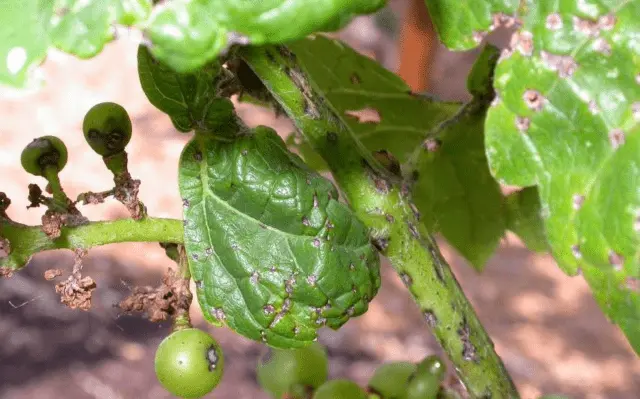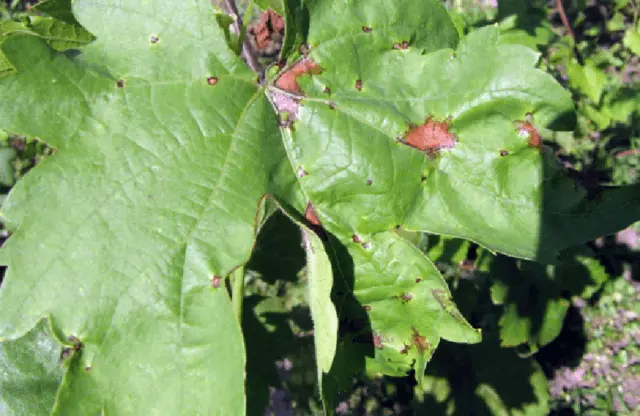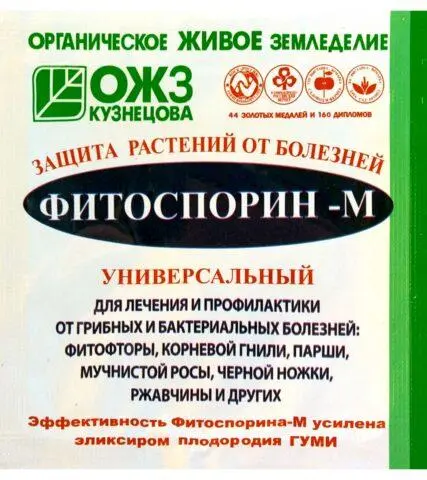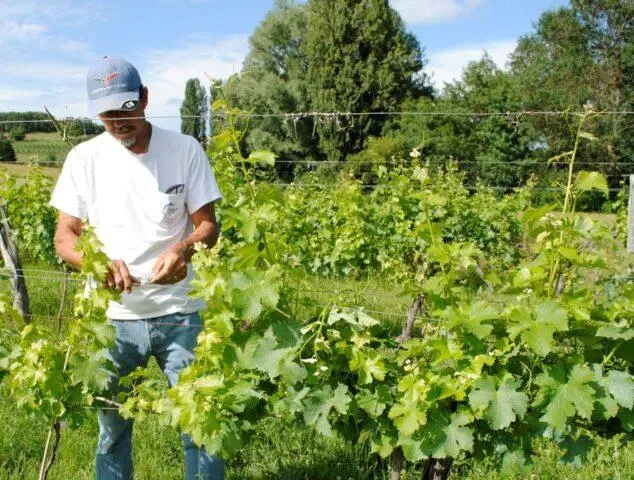Contents
Grape anthracnose is a dangerous fungal disease that affects many varieties and leads to a decrease in yield, lag in development, and in advanced cases, to the death of the shrub. The pest quickly infects the ground part of the plant, and is active in relatively warm and rainy weather. Therefore, for prevention, it is necessary to observe the norm of watering, as well as inspect the shrubs and carry out treatments using special preparations.
The causative agent of grape anthracnose
Anthracnose (also spotted anthracnose) is an infectious disease caused by the fungus Gloeosporium ampelophagum Sacc. Not only grapes are susceptible to damage, but also other crops – most often it is currants, peas, tomatoes, apple trees, flax, cherries.
Microscopic fungi overwinter on the affected organs of grapes in the form of sclerotia, mycelium and pycnidia. They tolerate adverse environmental conditions well, multiply effectively (each fungus produces up to 30 generations of spores). Direct germination begins only under certain conditions:
- the presence of water drops;
- temperature above 10 degrees Celsius;
- no strong heat (no more than 40 degrees).
The main methods of transmission of the causative agent of grape anthracnose:
- seeds;
- the soil;
- leaves, branches and other plant remains.
The first symptoms
The causative agent of anthracnose can quickly infect the entire aerial part of the grapes – stems, shoots, foliage, fruits. The main signs appear already in the spring, if at this time it often rains, heavy dew falls. The first symptoms of grape anthracnose are noticeable on young shoots. Brown spots of a rounded or angular shape appear on the leaves, surrounded by a border of a dark or reddish hue. Over time, they merge and grow larger. In place of the spots, plant tissues dry out and die. Holes are formed.

Due to anthracnose, grape leaves massively become perforated.
Subsequently, new signs appear:
- oval brown-brown depressed spots on shoots;
- cracking of the surface of the branches;
- deep ulcers;
- drying and death of the vine;
- brown formations on the surface of the petals;
- shedding of flowers;
- wilting and death of brushes;
- dots with a dark border on the berries.
The second wave occurs in August and September. The degree of development of anthracnose depends on the weather. If it rains a lot, then the situation is noticeably worse.
Causes
Grape anthracnose is an infection, so its occurrence cannot be 100% excluded. In this case, it is possible and necessary to prevent the main causes of occurrence. The transmission of anthracnose fungi is facilitated by:
- deficiency of phosphorus and potassium in the soil;
- many insects (while they themselves do not suffer from spores);
- low pH (i.e. increased soil acidity);
- windy and rainy weather;
- a provoking factor may be excessive watering, the lack of a constant flow of air to the vine bushes.
How to deal with grape anthracnose
Methods for the treatment of such a dangerous grape disease as anthracnose should be sufficiently effective and applied systemically. Gardeners are trying to use folk remedies and biological preparations. They are relatively safe for the grapes themselves and other plants, as well as for humans, beneficial insects and animals. But if the disease is running, chemicals are used. The most effective means are described below.

Chemicals are most often used to fight infection.
Folk remedies
Folk remedies are effective only at an early stage of infection. They are used in several cases:
- preventive treatment in early spring;
- spraying when the first symptoms appear;
- treatment of anthracnose of grapes during the ripening of berries.
The main recipes are:
- Put the hay on the ground so that it rots, then pour it into a container (up to a third of the volume) and fill it with water. Endure a week. Strain and use the resulting infusion to carry out several treatments of the vineyard after rain with an interval of 10-15 days.
- Grind a few garlic cloves (100 g) and insist in 10 liters of hot water. After a day, add 50 g of laundry soap shavings, 2 tbsp. l. salt and 50 ml of potassium permanganate or ferrous sulfate (in both cases, the concentration of the solution is 1%).
- A solution of baking soda (sodium bicarbonate) – 200 g per 1 liter. You can add 2-3 tablespoons of laundry soap shavings or liquid detergent.
- Milk whey, kefir or yogurt – 1 liter per 10 liters of cold water. You can also add some soap to this solution.
It is important to understand that folk remedies, although safe, are not very effective. Therefore, if the disease has already begun to develop, it is better to use chemical or biological fungicides. Otherwise, you can miss the time, and then part of the grapes will die.
Biological preparations against anthracnose of grapes
Biological preparations contain strains of microorganisms. They effectively destroy spores, mycelium and other parts of fungi. They are used both for the prevention and treatment of grape anthracnose. Popular biofungicides include:
- “Fitosporin M” is a safe drug that strengthens the immunity of grapes and many other crops. It is used at a dosage of 5-10 g per 10 liters of water.
- “Alirin B” is used to destroy the causative agent of grape anthracnose in the soil. Can be used alone and together with other biofungicides, but not in combination with chemicals.
- “Trichodermin” is a safe drug that is used in the amount of 200 ml of liquid per 10 liters.

“Fitosporin M” – one of the best biological agents of universal action
Fungitsidы
Modern chemicals that can be used to treat grape anthracnose include:
- “Abiga-Peak” is an anti-anthracnose drug containing copper oxychloride. Used in the amount of 50 g of suspension per 1 liter.
- “Fundazol” is a systemic fungicide for the treatment of anthracnose. Used for watering the soil and processing the ground part of the grapes.
- Polyram is a powerful contact fungicide that is used no more than four times a year. Dissolve 10-5 g of powder in 10 liters of water.
You can use such drugs: “Risotorfin”, “Nikfan”, “Phosphobacterin”, “Azotobacterin” and others.
Agricultural practices
For the prevention of anthracnose of grapes, it is recommended to use agricultural practices. They are not methods of treatment, but they serve as a good means of preventing the development of infection. And if the bush has already suffered, proper care will help speed up recovery. The main agricultural practices include:
- Proper planting of bushes in compliance with the minimum interval of 1,5-2 m or more (depending on the variety).
- Improving the ventilation of the crown – timely pruning, breaking off branches, pinching, thinning.
- Periodic inspection of bushes and removal of affected shoots (it is better to burn them).
- Removing foliage in autumn. The litter must be taken and burned or thrown away.
- Treatment with insecticides and folk remedies for the destruction of insects, many of which are carriers of anthracnose.
- Compliance with the norm of watering – many varieties of grapes are drought-resistant, so they are given water no more than twice a month.
- Timely fertilization, loosening and weeding help to increase the resistance of grapes to adverse weather conditions, anthracnose and other diseases and pests.
- The use of foliar dressings on the sheet is a solution of zinc or manganese sulfate of low concentration (up to 0,2%).

One of the preventive measures is maintaining the distance between the bushes and thinning the crown.
Preventive treatment
Preventing the development of grape anthracnose is much easier than dealing with the consequences. Along with the agricultural practices described above, preventive treatment with chemical or biological preparations should also be carried out every spring:
- “Fitosporin”;
- “Abacus Ultra, SE”;
- «Strekkar»;
- “Ridomil”;
- urea;
- Bordeaux liquid;
- copper, iron sulphate.
The first spraying is carried out in early spring, before the buds begin to swell, then two more with an interval of 10-15 days. During the procedure, it is also recommended to clean and pour the near-stem circle of the shrub with a solution of the drug.
Anthracnose resistant grape varieties
Many grape varieties are resistant to anthracnose infection. They can also suffer from the disease, but much less frequently compared to other varieties. Most often, gardeners prefer the following varieties: Nimrang, Saperavi, Tsolikouri, Sauvignon, Riesling.
You should also take into account the varieties that are most vulnerable to anthracnose (while they are resistant to downy and powdery mildew): Isabella, Husain, Lydia, Karaburnu.
Conclusion
Grape anthracnose often affects the crop. Even if the variety is resistant to this disease, it still needs preventive treatment. In case of infection, they begin to fight the infection as early as possible, and for this it is advisable to use not folk remedies, but special preparations.









